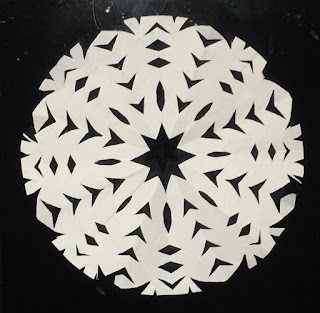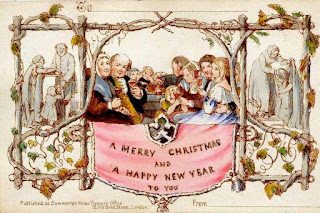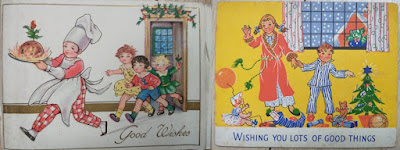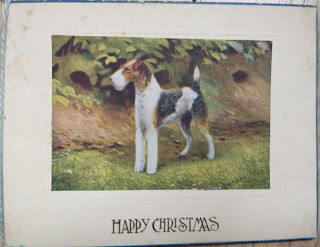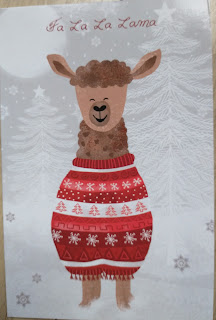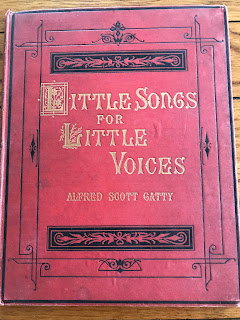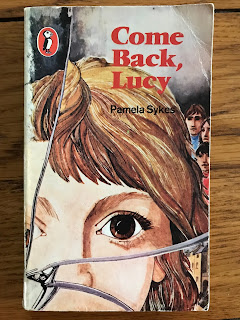I do like a good dragon! The fearsome, treasure-loving Smaug in The Hobbit has got to be one of the best ever. His creator, the celebrated writer and Oxford Professor of Anglo-Saxon, J.R.R. Tolkien modelled him on the vengeful, treasure-hoarding dragon in the epic Old English poem, Beowulf which the legendary monster-slayer and hero must face in the final, epic battle of his life.
The fire-breathing Smaug from ‘The Hobbit’
by J.R.R Tokien,
in an illustration by the author. Can you spot Tolkien’s
hobbit hero,
Bilbo Baggins bravely doffing his cap to him? (Authors own photo of
postcard)
My own wartime adventure, The Buried Crown has a dragon or two in it too. The book tells the story of two brave children – London evacuee, George Penny and German Jewish refugee, Kitty Regenbogen – who get caught up in a desperate race against time to find and rescue a priceless piece of Anglo-Saxon treasure before a bunch of Nazi treasure-thieves can get their hands on it in a bid to change the course of the war.
It was inspired by the discovery of the now famous Anglo-Saxon Sutton Hoo Ship Burial treasure in the summer of 1939, a few weeks before the outbreak of war. Excavating at a site just outside the town of Woodbridge in Suffolk, archaeologists unearthed the remains of what turned out to be an early 7th century long-ship buried deep beneath the largest of a series of ancient burial mounds belonging to local woman, Edith Pretty.
The archaeological excavation of the
largest burial mound at Sutton Hoo
revealed the impression of a ghostly ship
the length
of two double-decker buses (Author’s own photo of
postcard)
Though the timbers of the ship itself had rotted way to leave nothing but a ghostly imprint and lines of rusty rivets in the soil, a wooden shelter inside contained goods which ranged from humble domestic objects such as cups, bowls and spoons, to weaponry and gorgeous items of treasure including a purse filled with gold coins, a great golden belt buckle and a magnificent helmet. At the time it was described as the British equivalent of the celebrated Tutankhamun discovery and remains one of the richest archaeological finds in Northern Europe.
Following decades of research by archaeologists and historians, the most widely-held belief today is that the ship was the burial site of the pagan ruler, Redwald, King of the East Angles and High King of Britain and that the goods it contained were intended for use by the king in the afterlife.
One of the many fascinating things about the treasure is the appearance on some of the most precious items, including the famous Sutton Hoo helmet, shield and sword-belt, of dragons. These are very stylised and not at all like the modern idea of dragons as depicted in the movie version of The Hobbit and HBO’s Game of Thrones. But, if you know how to look, they will reveal themselves to you, emerging as creatures with red garnet eyes, beak-like faces and wings either tucked along the length of their body or spread wide, as in the case of the helmet, to form the eyebrows of its awe-inspiring, mask-like face. They are also a part of the celebrated animal interlacing – a trademark feature of much Anglo-Saxon art – and of which the priceless Sutton Hoo belt buckle is a stunning example.
Shield boss – Replica of
the boss from the king’s shield ringed
by a circle of ‘beaked’ dragons heads
with red garnet eyes (Author’s own photo)
Gold and garnet dragon
- This highly stylised dragon is one of the shield
mounts and features a
fearsome set of spiked jaw, a red garnet eye
and a line of ‘winglets’ fringing
both sides of its body. (Author’s own photo)
Replica of the famous
Sutton Hoo helmet -
Can you spot the dragons? (Author’s own photo)
The Anglo-Saxons loved – or perhaps I should say lived in dread – of dragons. They believed there were two types. ‘Drakes’, who breathed fire and could fly like Tolkein’s Smaug, and wingless ‘wyrms’ who slithered across the landscape like giant reptiles. The creatures lived inside burial mounds like the ones King Redwald’s ship was discovered beneath at Sutton Hoo, and guarded the treasure buried inside them, exacting the most dreadful revenge on anyone who dared try and steal it away from them.
Beware a burial mound
like this one at Sutton Hoo – it might be the home of a dragon!
(Photo used by kind
permission of The National Trust)
This idea of an ancient and angry treasure-guardian, so powerfully depicted in the Anglo-Saxon epic poem, Beowulf, provided the inspiration for my own ‘story within a story’ in The Buried Crown. Known as The Legend of the Dragon-Headed Crown, it became the ‘foundation myth’ for the magic which leaks into the world of my heroes, George and Kitty as the story progresses.
And the dragons depicted on the treasures at Sutton Hoo – perhaps as protection against thieves? – gave rise to my own piece of dragon treasure which – spoiler alert! – might just have special powers of its own.
You can visit the real-life treasures found at Sutton Hoo in the Early British Medieval Galleries at the British Museum in London. Or if you can’t make it there in person, check them out on the excellent museum website. And if want to visit the site of the excavations at Sutton Hoo, view the burial mound field and see more exhibits on the treasures and the life and times of the Anglo-Saxons who made and buried them there, why not take a trip to Sutton Hoo itself, now in the property of the National Trust.
Writing prompt
Take a look at dragons in other cultures – either writings or images; historical or modern. How might their depiction inspire you to create a dragon of your own? What might you borrow and what would you discard? What is their purpose, their power, their name? Happy dragon-hunting!
Ally Sherrick is the author of books full of history, mystery and adventure including Black Powder, winner of the Historical Association’s Young Quills Award 2017, The Buried Crown and Tudor-Set adventure, The Queen’s Fool. She is published by Chicken House Books and her books are widely available in bookshops and online. You can find out more about her and her books at www.allysherrick.com and follow her on Twitter: @ally_sherrick










